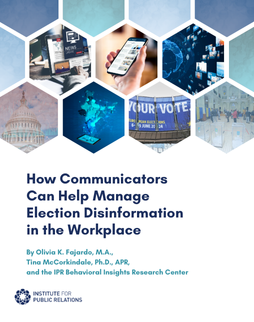Most public relations practitioners intuitively believe in the power of media coverage to create the awareness, knowledge, interest and intent that is needed to achieve desired behaviors by target audiences. But how much media coverage is needed to affect change, and is more really better? And before you say yes, when and where have you seen it proved?
A new Institute paper by Angie Jeffrey (VMS), David Michaelson (David Michaelson & Company), and Don Stacks (University of Miami) is entitled “Exploring the Link Between Volume of Media Coverage and Business Outcomes.” And that’s what it does.
Media coverage is sometimes measured by counting clips, audience impressions, and the media value if the same space or time were purchased. At a more sophisticated level, volume measures may consider other factors like tone, accuracy and target audience reach. But this paper goes beyond all that and offers case studies comparing quality and quantity of media coverage with business outcomes, using an artificial-intelligence linguistics tool to analyze huge numbers of articles.
In the first of several cases, a healthcare organization extensively publicized the importance of mammograms. The campaign included no paid media or promotional activity, depending entirely on media coverage. Comparing media patterns with business results (visits to doctors’ offices to discuss a mammogram), it’s clear that business results marched upward with volume of coverage and fell when coverage declined.
A second case deals with the effects of negative story volume, and whether the old adage, “bad publicity is better than no publicity” is really true. It’s not.
Finally, a third case illustrates how media coverage that simply mentions a brand without delivering a meaningful message may not have much impact. The product was a medicine for overactive bladder, with prescription volume as the business outcome. An analysis of 3,000 articles showed only modest correlation between coverage volume and prescription volume. But the correlation of coverage with prescriptions soared when at least one key message made it into the story.
The moral: define your business outcomes, define your messages, and work like crazy to get those reflected in as many relevant media sources as possible.
Frank Ovaitt
President and CEO
Institute for Public Relations




Doing product publicity takes us back to the fundamental debate about public relations: is PR about public interest or persuasion. Angie and David can help us immensely if they also discuss about where to draw the line between publicity and media manipulation.
Congratulations to the authors of the study for adressing the issues of ‘volume’ that were at the heart of John Naisbitt’s research for his seminal work ‘Megatrends’ in the 1980’s and the MegaTrends 2000.
It is good to see public relations research nailing the ‘awareness’ myth peddled by our advertising colleagues. Our mantra at PIELLE based on MIT research is that ‘awareness’ without ‘understanding’ has only a 15 percent effectiveness and creates only limited latent demand. Effectiveness we preach comes from adding the understanding – the messaging now we have researched proof.
Thanks
PLW
I have always believed that the great “myth of media relations” is that its success is purely quantifiable. Many managers even rate those who report to them in terms of the number of articles or hits in the media that they place.
That is at best misleading.
The key to success is —audience, audience, audience! Understand who your primary audience(s) are and craft your message accordingly. Having done that determine which vehicles will not only reach your audience, but which ones that they will they find credible.
There have been times in my experience when I have needed to target a small number of influencers on a particular issue or piece of legislation. In such cases I sought out the publications, broadcast outlets and web sites which attract them. It might be through an academic journal. It might be through local TV or radio political shows. It might even be through radio music programs hosted by the hottest DJs.
Or, it might be all fo the above.
Surely there are times—product introductions, consumer warnings, celebrity publicity—when practitioners go for as much exposure as possible, opting for national TV, the national newspapers and magazines. But increasingly, with the diversity of media options, savvy practitioners target their audiences where they are most comfortable.
So it all goes back to PR 101—understanding your audience. When teaching public relations, one assignment I do is ask the class which voting blocks are most important during a political campaign. They always respond with the usual suspects: women, labor unions, soccer moms, the rich, the middle class, African-Americans, Hispanics, pro-choice, anti-abortion and on.
I list them on the board until all they have exhausted all the choices. Then I erase the board and say: “The answer is not up here.” After that I write the correct answer: “Likely voters.”
Audiences. You gotta know ‘em.